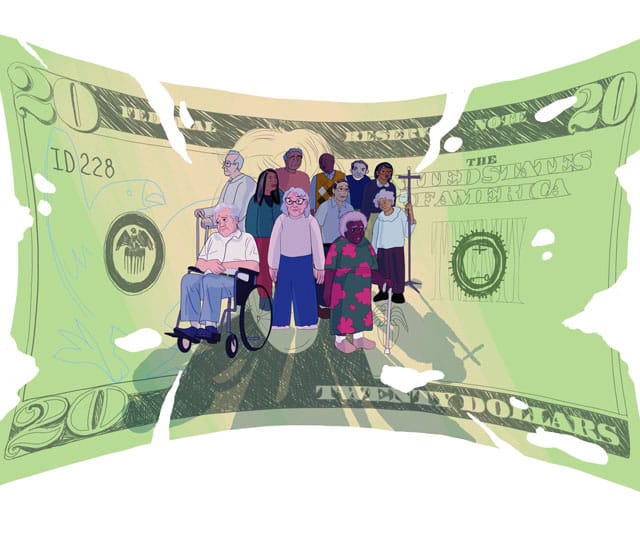More than 71 million Americans receiving Social Security benefits will see their checks rise 3.2% next year to help them keep pace with inflation, the Social Security Administration said Thursday. That’s more than the typical cost-of-living adjustment but a significant drop from the record-setting bump of 8.7% in 2023 amid rampant inflation.
Starting in January, retired workers’ average benefit will rise $59 monthly to $1,907, up from $1,848.
“Retirees can rest a little easier at night knowing they will soon receive an increase in their Social Security checks to help them keep up with rising prices,” Jo Ann Jenkins, CEO of AARP, said in a statement. “We know older Americans are still feeling the sting when they buy groceries and gas, making every dollar important.”
Retirees and their dependents receive more than three-quarters of all Social Security benefits paid, but millions of other beneficiaries will also receive the increase, including disabled workers, survivors of workers and low-income people as part of the Supplemental Security Income program. The latest bump in benefits exceeds the 2.6% average over the past 20 years, experts said.
Prices are still elevated, but have eased considerably since pandemic-related disruptions and supply shortages drove them up sharply. The Federal Reserve has tried to cool inflation by raising its benchmark interest rate, in a series of moves, to its highest level in 22 years.
Social Security benefits are particularly important to lower- and middle-income retirees, many of whom do not have workplace retirement accounts such as 401(k)s, and the matching contributions from employers that often accompany them. But what really sets Social Security apart from other sources of retirement income are its lifetime inflation adjustments, which help retirees maintain their buying power as the costs of housing, food and medical care rise. This is especially crucial if Social Security makes up most or all of a household’s income.
“Unlike Social Security, the value of private savings — like 401(k)s and IRAs — erodes over time,” said Kathleen Romig, director of Social Security and disability policy at the Center on Budget and Policy Priorities, a nonpartisan research and policy group. “Most pensions aren’t adjusted for inflation, either. Social Security is the only form of retirement income that keeps up with inflation.”
Retirees often see some of that extra money eaten up by rising Medicare Part B premiums, which cover doctor visits and outpatient hospital services and are automatically deducted from Social Security checks. In its annual report to Congress, the Medicare board of trustees projected that premiums would rise to $174.80 in 2024, up from $164.90.
If that holds, the typical retiree would still have some money left over from the cost-of-living adjustment, said Mary Johnson, Social Security and Medicare policy analyst at the Senior Citizens League, an advocacy group for older Americans.
Because any potential cost-of-living adjustment must be baked into benefits at the start of the new year, beneficiaries receive raises after they’ve already experienced higher prices. The COLA is calculated using the consumer price index for urban wage earners and clerical workers (called the CPI-W): Social Security takes the average inflation reading from July, August and September of the current year and compares that with the same period from a year earlier. Any increase results in a pay bump.
There has long been a debate about whether the CPI-W index is the most accurate gauge to calculate Social Security adjustments because it tracks a basket of goods and services purchased by working people, not retirees. Retired individuals tend to spend more of their income on housing and health care, which may be better reflected by another experimental measure called the consumer price index for the elderly, or CPI-E, which tracks people 62 and older.
“If that was the law today, the COLA in 2024 would be higher,” Johnson said. She said the COLA adjustment would be about 1 percentage point higher than the raise announced Thursday. The CPI-E doesn’t always lead to a higher inflation adjustment, however, and differences between the two indexes have narrowed in recent years.
And some experts say tinkering with the inflation mechanism has become a less significant issue in the face of Social Security’s looming financing shortfall, which, if left unaddressed, would lead to significant benefit cuts across the board. The trust fund that pays retiree benefits, which is paid for primarily through payroll taxes, will be depleted in 2033, at which time the program could only fund 77% of total scheduled benefits.
The payroll tax is split between employers and employees, who each paid 6.2% of wages in 2023, up to a taxable maximum income of $160,200. Next year, up to $168,600 of earnings will be subject to these taxes. The only way to close the funding gap is to raise these taxes — or have them cover more earnings — or to shave benefits, all of which require congressional approval.
“The Social Security Administration puts out this book that has hundreds of ways to raise revenue and hundreds of ways to cut benefits,” said Alicia Munnell, director of the Center for Retirement Research at Boston College. “It is not an intellectual exercise. It is a political exercise. And I don’t think Congress wants to see a cut of benefits of 23% across the board.”
c.2023 The New York Times Company. This article originally appeared in The New York Times.







